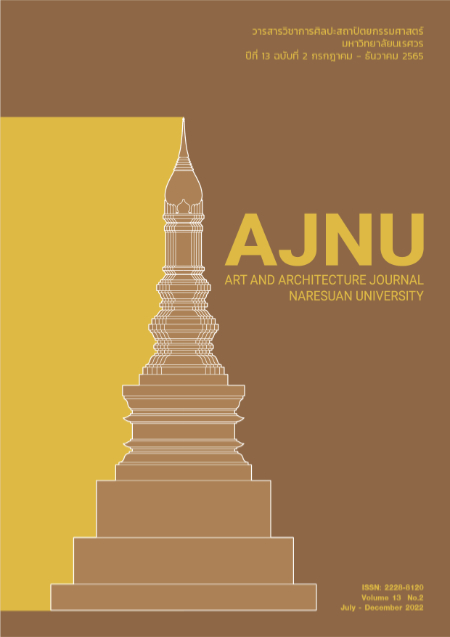Potential Growth of Agrotourism: Effects of soybean concentrations and temperatures for dyeing cotton with marigold petal for souvenir products
Main Article Content
Abstract
The objectives of this research were to study 1) effects of temperatures and soybean concentrations for dyeing cotton from marigold petal to nitrogen content, color, colorfastness to laundering and colorfastness to light 2) Selection of tie-dyed pattern the marigold petals dye for souvenir products development. The experimental of temperatures: at 30, 60 and 90 °C and three ratio soybean concentrations: 1:5, 1:10 and 1:15. It was found the temperatures, the soybean concentrations interaction between the temperatures and the soybean concentrations significantly affected the nitrogen content, L*, a*, b*, C* and h* (p£.05). Using temperature at 90 °C ratio soybean concentrations 1:10 the dyed cotton fabric has nitrogen content 0.47 g/100 g of fabric L*, a*, b*, C* and h* values were 59.41, 9.48, 50.06 and 79.28 respectively. The colorfastness to laundering in terms of color change and color staining were in the level 3 and 4.5. Colorfastness to light were in the level 3.5. 2) The results of the evaluation 3 groups of tie-dyed patterns are found the overall satisfaction of the polygon patterns has the number 1 average rating (4.27) the second was the straight line and oblique stripes patterns and Multi-curve and circle pattern (4.17).
Article Details

This work is licensed under a Creative Commons Attribution-NonCommercial-NoDerivatives 4.0 International License.
References
กรมหม่อนไหม กระทรวงเกษตรและสหกรณ์. (2560). สารช่วยย้อม. สืบค้นเมื่อ 15 สิงหาคม 2561, จาก
https//www.qsds.go.th/qsis_netu/inside.
จุฬาลักษณ์ เทพหัสดิน ณ อยุธยา. (2561). ผลการตกแต่งด้วยไคโตรซานต่อการติดสีจากกลีบดอกดาวเรือง. ปร.ด.,
มหาวิทยาลัยเกษตรศาสตร์. กรุงเทพมหานคร.
นุจิรา รัศมีไพบูลย์. (2543). สภาวะที่เหมาะสมสำหรับการย้อมผ้าไหมด้วยกลีบดอกดาวเรือง. ค.ศ.ม.,
มหาวิทยาลัยเกษตรศาสตร์, กรุงเทพมหานคร.
สุรีย์ แถวเที่ยง. (2552). เครื่องดื่มน้านมถั่วเหลืองผสมแครอท. ค.ศ.ม., มหาวิทยาลัยเทคโนโลยีราชมงคลพระนคร.
กรุงเทพมหานคร.
สำนักงานมาตรฐานผลิตภัณฑ์อุตสาหกรรม .(2557). มาตรฐานผลิตภัณฑ์ชุมชน ผ้ามัดย้อม. กรุงเทพมหานคร: สำนักงาน
มาตรฐานผลิตภัณฑ์อุตสาหกรรม กระทรวงอุตสาหกรรม.
AATCC. (2010). Technical Manual Volume 85. North Carolina: American Association of Textile Chemists and
Colorists.
Jothi, D. (2008). Extraction of Natural Dyes from African Marigold Flower (Tagetes ereecta L.) for Textile.
AUTEX Research Journal. 8(2), 22350-22354.
Harlapur S. F., Harlapur Sujata F. & Nagaswarupa H. P. (2018). Marigold: Eco-friendly Natural Dye for Fabrics.
Materialtoday Proceedings. 2018(5), 22350-22354.
Loum, J., Lukyambuzi, H. and Kodi, P. (2013). Effect of Mordants of Dye from Vernonia Amygdalina on Cotton
Fabrics Coloration. Journal of Language Tecnology & Enterprenenurshin in Afica. 4(2), 17-27.
Young, J. N. and Shin, H. L. (2014). Natural Dyeing of Soybean Protein Fabrics Gallnut. Fashion and Textile Research
Journal. 16(3), 462-468.
Zerin, I. and Foisal, A. B. M. (2016). Effect of Mordanting Process on Cotton Dyeing with Acacia Catechu Effect
of Mordanting Process on Cotton Dyeing with Acacia Catechu. The 3rd Textile Research Conference (TRC), 29 October 2016, Dhaka, Bangladesh.


